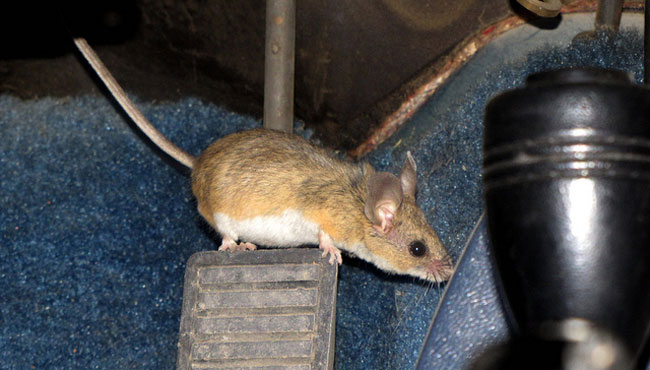Rodent Damage to Vehicles
By Chris Williams on August 28, 2013.

Question
When I took my car in for its checkup, the technician told me that it looked like mice had been chewing on the wires! Even though my car is only a year old, the manufacturer said this kind of damage is not covered under the warranty. It cost me $600 to have the damaged wiring replaced. What can I do to keep this from happening again?
Answer
We’ve been hearing quite a few complaints lately about this very issue. Although we’ve always known that mice, and other rodents like squirrels, will gnaw on wiring just because they like to gnaw (and sometimes for the road salt)—apparently something else is going on here.
The word is that several years ago, automakers started using biodegradable, soy-based wiring insulation. This was the manufacturers’ concession to going “green” because the soy-based wiring degrades in landfills, unlike the older petroleum-based, plastic-covered wiring. Unfortunately, the manufacturers didn’t consider possible ramifications. Soy is food-based; rodents are attracted to it, so they are even more likely to chew on wiring that has a soy-based covering. Even worse, automakers are starting to make other car parts, like seat padding, with soy-based materials.
There’s not much you can do about your car’s wiring except to try to protect it. Honda dealers sell rolls of anti-rodent tape for wires and there are various types of rodent repellents that people use under the hood or spray on wires. I would be leery of many of these repellents because of the possibility of fire and odor. Don’t put mothballs under the hood. It’s an illegal use and that air is what you’ll be smelling when you turn on the heat or A/C. The best protection is prevention of rodents in the first place.
Rodents Nest in Vehicles, Too
You are more likely to have gnawing damage to wires if rodents are also nesting in your vehicle. Rodents frequently will nest in cars because of the shelter, warmth, food, and nest material (hood insulation, foam padding, wire insulation, and anything else you provide) near by. Vehicles that are used infrequently and rarely disturbed are the most likely to become home to rodents.
NOTE: If rodents have built a nest or nests in a vehicle, use precautions to avoid inhaling disease organisms when cleaning out the nest material and droppings. Ventilate the area, spray the nest and droppings with disinfectant and let sit for several minutes. Wear gloves and a respirator and dispose of the mess in a sealed plastic bag.
Keeping Rodents Out of Your Car
The most obvious preventive measure is to use the vehicle frequently and keep it in a garage—but then you also have to make sure that the garage is kept rodent-free:
- Make sure there are no rodent food sources nearby. If dry pet food is stored in the garage, relocate it or make sure it is in a tightly-sealed, rodent-proof container. Likewise, for any garbage cans or recycling bins in the garage. Bird seed and grass seed are rodent foods, too.
- Relocate or make sure you frequently clean any pet litter boxes (yes, rodents eat pet poop) in the garage.
- Place some baited snap traps around your garage to intercept any rodents that might get inside and to attract them to a food alternative other than your car’s wiring.
- If you know you have a mouse problem in your garage, have a pest control company conduct an inspection, rodent-proof the space, and put a rodent management program in place. It’ll be cheaper than repairing car damage.
Clean out your car or truck. Rodents like clutter for nesting and hiding. If the back seat of your car is covered with dog hair, food wrappers, spilled food, newspapers, and clothes, you are not only providing nest sites and nest material, you are also providing food for mice.
Check under your car’s hood frequently. Spotting gnawed wires may be difficult but you might spot twigs, leaves, and insulation making up a mouse nest.
photo credit: Fool-On-The-Hill via photopin cc